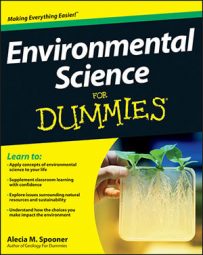Persistent organic pollutants (POPs) are nonbiodegradable compounds, so called because they stick around for a long time, polluting the environment and causing illnesses. While many modern pesticides are made to degrade into their original elements and molecules so that they aren’t toxic as they move through the ecosystem, other substances such as plastics and other manmade chemicals don’t biodegrade. Some common POPs include
Bisphenol A (BPA): You find BPA in polycarbonate plastics — the hard, clear plastics that many water bottles are made of. This compound is an endocrine disrupter and likely affects reproductive systems. Scientists are still studying the immediate health risks of BPA, but they have linked it to miscarriages and mental retardation in animals.
Polychlorinated biphenyls (PCBs): You find PCBs throughout your home in the electrical wiring insulation, paint, flame retardants, and sealants (like the caulk around your bathtub). These toxins are manmade organic compounds that act as immune system depressants — keeping the immune system from properly responding to threats. Remember that in this case, organic simply means the molecules contain carbon.
Polybrominated diphenyl ethers (PBDE): PBDE is a flame retardant commonly used in fabrics and furniture foam, although you also find it in plastics and appliances. It’s chemically very similar to PCB and has been banned in Europe. In studies, it has been shown to disrupt thyroid function and cause neurological damage in laboratory animals.
Perfluorooctane sulfonate (PFOS): You find PFOS in nonstick and stain-resistant products, including Teflon (for cooking pans), Gore-Tex (for weatherproof outdoor gear), and Scotchgard and Stainmaster (for carpets and upholstery). These compounds can withstand high levels of heat and are used in the manufacture of numerous products.
They’re carcinogens and have caused brain damage and reproductive damage in rats. Studies are currently underway to determine their effect on humans, and early results suggest that females may be more sensitive to their toxicity than males.
Phthalates: You find phthalate compounds in everyday products such as makeup, plastic food packaging, body care products, and children’s toys. Some phthalates have been shown to kill laboratory animals and have been linked to reproductive issues in humans. Studies are still underway to determine whether these endocrine disrupters are responsible for a trend toward lower sperm counts in men in the United States over the last 50 years.
Perchlorate: Perchlorate is a chemical found in rocket fuel and other propellants. You may assume that you’re safe from this toxin if you haven’t been near a rocket recently, but perchlorate gets into water supplies and enters the food chain when farmers use that water to water animals and crops.
It was widely spread across the United States during missile-testing activities through the mid-20th century. Perchlorate is an endocrine disrupter that scientists have found in recent human breast milk samples from across the United States.
Atrazine: Atrazine is one of the most commonly used herbicides in the United States. Humans use it on crops, parks, golf courses, and other vegetation. Several European countries have banned atrazine, though it’s still used in other countries around the world, including the U.S. It’s an endocrine disruptor, and scientists find that nearly all surface waters in the U.S. have some amount of atrazine in them today.

